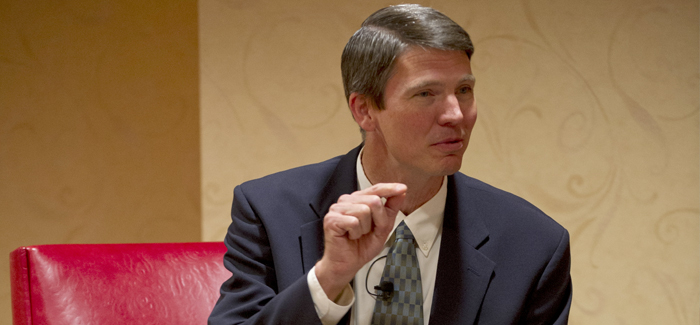
Fuerst pointed out impending risks. (Photography by Barbara Johnston/University of Notre Dame)
Timothy Fuerst’s prescient models help shape monetary policy in the wake of the financial crisis.
Questions motivate Timothy Fuerst, AM’87, PhD’90, the William and Dorothy O’Neill professor of economics at the University of Notre Dame. “How should a government respond to this economy? What should regulatory behavior be? How should I think about health care reform? How do I think about development in poor countries?” he asks rhetorically, describing the wide-ranging curiosity that informs his work. Economics, he says, offers an “elegant way to think about answers.”
At Notre Dame and the Federal Reserve Bank of Cleveland, where he has served for nearly two decades, Fuerst analyzes proposed monetary policy using economic models, building systems of mathematical equations that simulate a modern economy’s complex workings. Economists apply theoretical shocks to some part of the model (say, house prices), measuring different monetary policies against the model’s outcomes.
Fuerst’s theoretical models have been influential. According to the Research Papers in Economics database, he ranks in the top 5 percent of most-cited contemporary economists.
“It’s one thing to sit around and talk in a bar about these questions,” Fuerst says in his office, decorated with miniature Michelangelo sculptures and pictures of his family. “It’s another thing to take the idea and turn those into a series of mathematical statements that one could take and turn into computer code.”
Fuerst’s understanding of the complexities became apparent after the recession of 2008, when economists turned to models like his to explain how a Gordian tangle of financial faults had ensnared the entire US economy. Fuerst “was ahead of his time in the 1990s in thinking about the financial frictions in the macroeconomy,” says his Notre Dame colleague Eric Sims. “But at the same time, he’s doing work that’s right in the center of the mainstream in the sense that it’s talking about issues that are relevant for current policy making and in particular for current monetary policy.”
In Fuerst’s 1992 “liquidity effects” model, which grew out of his thesis work at Chicago, the central bank does not inject cash evenly into an economy, as previous models tended to suggest. Instead, cash is first poured into one section of the economy—namely financial markets—and then flows out from there. It’s the difference between water poured into an ice-cube tray and into a bowl.
“Those are important models again,” Fuerst notes. “The central bank today is purchasing some assets, long-term bonds, and selling others, short-term bonds. Like they’re taking some water out of one cube and putting it into another”—a nonsensical exercise if cash flows freely.
Fuerst’s “agency cost” model, published as four papers from 1997 to 2000, elaborates on “non-trivial lending problems,” which arise when a borrower’s collateral—a house, for example—depreciates in value, eroding the necessary trust for a lender to be willing to sustain a loan.
After the 2008 recession, Fuerst explains, the agency cost model helped explain why the housing bubble led to a far worse recession than the early 2000s dot-com bubble did. Because homeowners heavily leveraged their homes for loans (which were then circuitously insured and reinsured), falling house prices toppled a chain of financial dominoes. “Economists are working harder to incorporate financial market imperfections and frictions into their macroeconomic models,” Sims says, “and Tim’s work is really fundamental in that sense.”
Fuerst began incorporating those factors into his models at Chicago, where he studied under professor Robert Lucas Jr., AB’59, PhD’64, the 1995 Nobel Prize winner in economics. Fuerst “had a complete vision of what he wanted to do and just went out and did it,” Lucas remembers.
In 1990, new PhD in hand, Fuerst joined the Kellogg School of Management. Kellogg reappointed him after three years, but by then his wife, Toni, had finished her medical residency and was pregnant with their first child. The couple returned in 1993 to their family roots in northwest Ohio, where Fuerst took a position at Bowling Green State University.
At Notre Dame since 2012, Fuerst is now drilling into three timely issues of monetary policy: how credit markets affect business-cycle behavior, the effects of zero interest rates on inflation and fiscal policy, and the efficacy of the Fed’s historically unusual bond-buying practice of quantitative easing. Like the entire economic field, Fuerst is trying to understand the nation’s recent financial sluggishness—and inform policy to protect against such dangers in the future.
It’s an all-consuming quest for Fuerst. “Once you start to think about economics,” he says, “it’s hard to think about anything else.”
